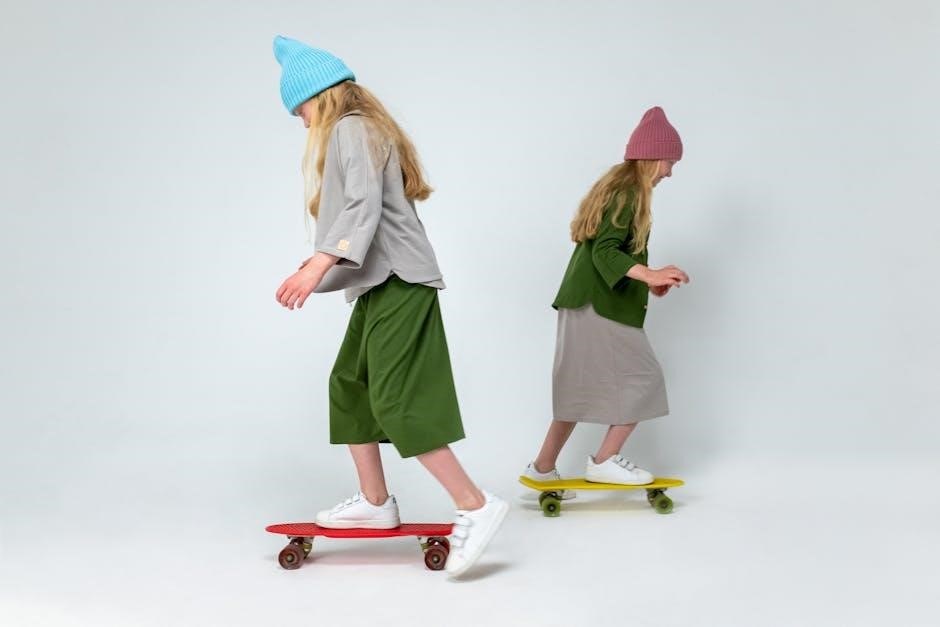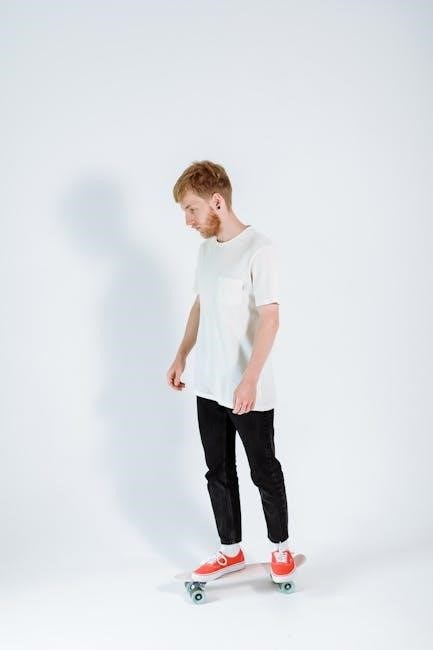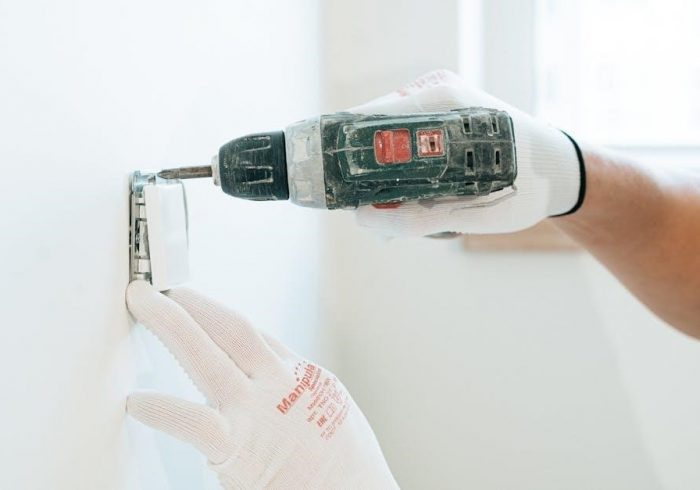Choosing the right skateboard size is crucial for optimal performance and comfort. This guide explores how deck length, width, and wheelbase impact your skating experience. Whether cruising or performing tricks, finding the perfect fit ensures better control and enjoyment; Riders of all sizes and styles will benefit from understanding these key dimensions to make informed decisions tailored to their needs and preferences.

Understanding Skateboard Components

A skateboard’s size and performance are defined by its deck, trucks, wheels, and wheelbase. The deck’s length and width affect balance and trick performance, while the wheelbase determines stability and maneuverability. Trucks and wheels influence turning and speed, making component harmony crucial for optimal skating.
Deck Length and Width Explained
The deck is the foundation of a skateboard, and its length and width play a significant role in performance and comfort. The width of the deck, typically ranging from 7.5 to 10 inches, is the most critical dimension, as it directly impacts balance and maneuverability. Narrower decks (7.5–8 inches) are ideal for street skating and tricks, offering precision and ease of flipping. Wider decks (8.5–10 inches) are better suited for cruiser and transition skating, providing stability and comfort for larger riders or those prioritizing speed. Deck length, while less standardized, affects how the board feels underfoot. Longer decks can offer more stability, while shorter ones enhance agility. Rider height, weight, and shoe size also influence the optimal deck size, ensuring proper foot placement and control. Understanding these dimensions helps skaters choose a board that aligns with their style and preferences, ensuring a more enjoyable and effective skating experience.
Wheelbase and Its Importance
Wheelbase, the distance between the inner mounting bolts of the front and rear trucks, is a critical factor in a skateboard’s performance. It directly influences stability, turning responsiveness, and overall ride quality. A shorter wheelbase (14–15 inches) offers tighter turns and easier maneuverability, making it ideal for street skating and technical tricks. Conversely, a longer wheelbase (16–17 inches) provides greater stability at higher speeds, suiting cruiser and longboard styles. The wheelbase affects how the board reacts to weight shifts and lean, with shorter bases being more sensitive and longer ones more forgiving. Proper wheelbase alignment with the rider’s foot placement ensures optimal control and balance. While deck length and width are more noticeable, the wheelbase fine-tunes the skating experience, balancing agility and stability based on the rider’s style and preferences. Understanding its role helps skaters tailor their setup for enhanced performance and comfort.

Factors Influencing Skateboard Size
The ideal skateboard size depends on rider height, weight, shoe size, and skating style. Taller or heavier riders may prefer larger boards for stability, while smaller riders benefit from more maneuverable sizes. Shoe size impacts foot placement and control, requiring proper deck width for comfort and performance.
Rider Height and Weight
Rider height and weight significantly influence the choice of skateboard size. Generally, taller or heavier riders benefit from larger boards, as they provide greater stability and control. For example, a rider measuring 193 cm and weighing 102 kg may find a wider deck more comfortable and easier to maneuver. Conversely, smaller riders typically prefer smaller boards, which are lighter and more agile, allowing for better performance in tricks and tighter spaces. While these are general guidelines, personal preference plays a substantial role. Some taller riders may prefer smaller boards for street skating, while shorter riders might opt for larger boards for cruising. Ultimately, the key is to balance stability with maneuverability, ensuring the board complements the rider’s physical dimensions and skating style. Trying different sizes can help determine the most comfortable and effective fit, as there is no one-size-fits-all solution in skateboarding.
Shoe Size and Its Impact
Shoe size plays a significant role in determining the optimal skateboard size, particularly in terms of deck width. Riders with larger shoe sizes, such as a US 11.5 or EU 45.5, often benefit from wider decks to accommodate their feet comfortably. A wider deck provides better stability and prevents feet from hanging over the edges, which can hinder performance. Conversely, smaller shoe sizes typically pair well with narrower decks, allowing for easier maneuverability and trick execution. For instance, a rider with a shoe size of 7.75″ may find a deck width of 7.75″ to 8″ ideal. Shoe size also influences how a rider’s feet sit on the board, affecting balance and control. While personal preference and skating style are key factors, aligning deck width with shoe size ensures a more comfortable and efficient skating experience. This consideration is especially important for beginners, as proper fit enhances learning and enjoyment. Ultimately, matching shoe size to deck width helps riders achieve their full potential.

Skateboard Sizes for Different Riding Styles
Skateboard size varies significantly based on riding style. Street and park skating often use shorter, wider boards for tricks, while cruiser and longboard styles opt for longer, wider decks for speed and stability.
Street and Park Skateboarding

Street and park skateboarding typically require boards that are shorter in length and wider in width, providing stability and maneuverability for tricks. A common width for street skating is around 7.75 inches, allowing for easy flips and tricks. The deck length usually ranges between 28 and 32 inches, with a wheelbase of about 14 inches, enabling quick turns and control. Narrower boards are preferred for technical tricks, while slightly wider decks offer better stability for landing. Riders with smaller shoe sizes may opt for narrower boards, while larger feet benefit from wider decks. The setup is designed to accommodate fast movements and precision, making it ideal for urban environments and skateparks. Choosing the right size ensures comfort and enhances performance, allowing skaters to master tricks and navigate obstacles with ease. Whether you’re grinding rails or performing ollies, the right board size is essential for a seamless street or park skating experience.
Cruiser and Longboard Differences
Cruisers and longboards are designed for different purposes, with distinct size and shape characteristics. Cruisers typically have shorter decks, ranging from 28 to 32 inches in length, and are wider, offering stability for casual rides. Their wheelbases are slightly shorter than longboards, providing easier maneuverability. Longboards, however, are built for speed and comfort over long distances, featuring decks that are 33 inches or longer and wider wheels for stability. The longer wheelbase of longboards enhances balance at higher speeds, making them ideal for commuting or downhill racing. While cruisers are perfect for relaxed, carving rides, longboards cater to those seeking efficiency and speed; Both styles prioritize comfort and durability, with cruisers being more versatile for everyday use and longboards excelling in specific performance scenarios. Understanding these differences helps riders choose the right board for their preferred skating style and terrain, ensuring a more enjoyable and efficient experience.
Choosing the Right Width and Length
Selecting the ideal skateboard width and length ensures optimal performance and comfort. Wider decks accommodate larger feet, while narrower boards suit tricks. Longer boards enhance stability, while shorter ones improve maneuverability. Tailor your choice to your skating style, height, and personal preference for the best experience.
Common Skateboard Sizes and Their Uses
Skateboards come in various sizes, each catering to different riding styles and preferences. Standard widths range from 7.5″ to 8.5″, with 7.75″ to 8.25″ being the most common for street and park skating. Wider boards, such as 8.5″ or above, are ideal for cruiser or transition skating, offering stability and comfort. Length typically ranges from 28″ to 32″, with shorter boards enhancing maneuverability and longer boards improving balance.
Narrower decks (7.5″ to 7.75″) are great for younger or smaller riders, while wider decks (8.0″ and up) accommodate larger feet or provide more stability for cruising. The wheelbase, measured between the trucks, also varies, with longer wheelbases offering smoother rides and shorter ones enabling tighter turns. Understanding these dimensions helps riders choose a board that aligns with their skating style, whether it’s technical tricks, carving, or casual cruising.
Ultimately, the right size depends on personal comfort and skating goals. Testing different sizes can help determine the best fit for optimal performance and enjoyment.


